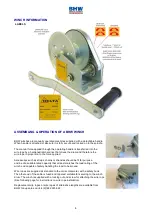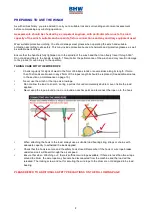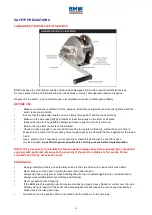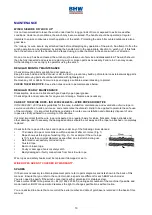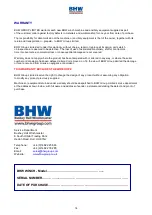
10
MAINTENANCE
WINCH SIEZURE OR ‘LOCK UP’
It is not recommended to leave the winch under load for long periods of time or exposed to extreme weather
conditions. Under such conditions, the winch may become seized. The handle should be operated at regular
intervals to ensure continuous smooth operation of the winch. Protecting the winch if mounted outdoors is also a
good idea.
If a ‘lock-up’ occurs, secure any attached load before attempting any operation of the winch. An attempt to free the
winch operation can be attempted by pulling the handle hard in the appropriate direction to ‘winch out’. If this fails,
then the extreme end of the handle can be tapped using a rubber hammer in the same ‘winch out’ direction.
Once a ‘lock up’ has been cleared, the winch must be taken out of service and disassembled. The winch should
then be fully inspected and serviced, replacing worn or broken parts as necessary. Failure to do so may cause
further damage, or even injury to operators using the winch.
REGULAR MONTHLY MAINTENANCE
Check all mounting bolts are tight and not damaged.
Keep the winch clean and free of dust or dirt in order to prevent any build up of material on external working parts.
All external-moving parts should be lubricated with lightweight oil.
Remove any dirt or debris from wire rope and apply a suitable aerosol dressing to protect.
CHECK THE WIRE ROPE
- See extra notes on wire rope maintenance below.
REGULAR YEARLY MAINTENANCE
Disassemble, clean and lubricate with good quality open gear grease.
Check all parts and accessories for any wear or damage. Replace as necessary.
CARE OF THE WIRE ROPE- ISO 4309:2004/2010 – WIRE ROPES DIRECTIVE
ISO 4309:2004 / 2010 details guidelines for the care, installation, maintenance and examination of wire rope in
service on winches, hoists and cranes, and enumerates the discard criteria to be applied to promote the safe use
of the machinery. It is important that these guidelines for safe care, installation and ultimately disposal of wire
ropes are strictly adhered to according to this directive.
It is most important that the wire rope is inspected on a regular basis, for kinks, flat spots, broken strands and
other damage, and if necessary the damaged sections should be cut away and the rope re-attached or completely
replaced.
Check both the rope and the hook and replace under any of the following circumstances:
•
10 strands of rope or more broken within a space of 25mm or more (Fig. 1).
•
Rope shows visible signs of wasting (Fig. 2) – for example, if the wire rope
is 10% less than original diameter as specified, due to stretch during use.
•
Deformed or excessively corroded rope.
•
Twisted rope.
•
Bent or broken rope.
•
Faulty or damaged hook or safety catch.
•
Badly damaged or faulty connections from hook to wire rope.
Wire ropes and safety hooks must be replaced if damaged or worn.
WIRE ROPES ARE NOT COVERED BY WARRANTY.
SPARES
If it becomes necessary to obtain replacement parts, refer to parts diagrams and lists shown in the back of this
manual. Ensure that you refer to the correct model, as parts are different for each BHW winch model.
You also need to specify if the winch concerned is either galvanized or stainless steel.
Please contact BHW Group sales on +44 (0)1482 223 663, quoting serial number of the machine if possible and
model number. BHW Group Limited reserves the right to change specifications without notice.
You are advised to ensure that a record of the serial number and date of purchase is recorded in the back of this
manual.
Содержание 10912
Страница 5: ...5 WINCH INFORMATION DIMENSIONS...
Страница 11: ...11 PARTS BHW1200 When ordering spares please specify whether winch is galvanised or stainless steel...
Страница 12: ...12 PARTS BHW1800 When ordering spares please specify whether winch is galvanised or stainless steel...
Страница 13: ...13 PARTS BHW2600 When ordering spares please specify whether winch is galvanised or stainless steel...






